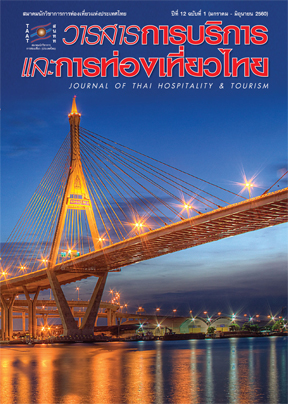Tourism: Tanintharyi River Dawei Territory of the Republic of the Union of Myanmar
Main Article Content
Abstract
The study on Tanintharyi River, Dawei, Tanintharyi District, Republic of the Union of Myanmar aims to explore new cross-border tourism. This research is a survey research which focused on collected data that actual happening and consequences. By the interviews focused on the questions and answers based on research objectives only in order to key informants could comment on views and attitudes on question was liberated. To ensure that quality and accuracy of the information received by Tri-angular check from different sources. The derived process of data focused on field survey to collect information and interview the spatial informants by using Snowball sampling techniques in the searching for the information from Key informant providing relevant tourist information. The results showed that Tanintharyi River is a potential river and abundant natural resources, livelihoods of Burmese and Karen on two sides of the river that rare to see in Thailand. As well as to be new knowledge of cross-border tourism.
Article Details
References
[2] Arreola, D. D. (1993). The Mexican Border Cities: Landscape Anatomy and Place Personality. Tuscon: University of Arizona press.
[3] Arreola, D. D., & Madsen, K. (1999). Variability of Tourist Attractiveness along An International Boundary: Sonara, Mexico Border Towns. Visions in Leisure and Business, 17(4): 19-31.
[4] Ball, D. (2009). Burma’s Nuclear Programs: The Defectors’ Story. Security Challenges, 5(4),
119-131.
[5] Ball, D. (2010). Burma’s Nuclear Program: Towards a Weapons Capability. Institute of Foreign Affairs and National Security, 18(2): 121-140.
[6] Bates, P. J., et al. (2005). A Review of the Genera Myotis, Ia, Pipistrellus, Hypsugo, amd Arielulus (Chiroptera: Vespertilionidae) from Myanmar (Burma), including Three Specied New to the Country. Acta Chiropterologica, 7(2), 205-236.
[7] Borneman, J. (1988). Grenzregime (Border Regime): The Wall and its Aftermath. Cambridge: Cambridge University Press.
[8] Charasrosjanakul, Surapong, et al. (2013). The Development of the Tourism Marker in order to link Thailand’s West to Economic Special Zone. Thailand Research Fund and National Research Council of Thailand.
[9] Charasrosjanakul, Surapong, et al. (2013). The Study of History Traces and Archeology of the Area along the Border. West of the Country Associated with the Dawei Special Economic Zone. Thailand Research Fund and National Research Council of Thailand.
[10] Dechruksa, Wivitchuta., Krailas, Duangduen., & Glaubrecht, M. (2013). Evaluating the Status and Identity of “Melania” Jugicostis Hanley & Theobald, 1876-An Enigmatic Thiarid Gastropod in Thailand (Caenogastropoda, Cerithioidea). Zoosystematics and Evolution, 89(2), 293-310.
[11] Elkins, T. H., & Burkhard, H. (1988). Berlin: The Spatial Structure of a Divided City. Methuen, London and New York.
[12] Goeldner, C. R. & Ritchie, J. R. B. (2006). Tourism: Principles, Practices, Philosophies. Hoboken: John Wiley and Sons, Inc.
[13] Hidalgo, L. G. (1993). British Shops Suffer as “Booze Cruise” Bargain Hunters Flock to France. The Times, November 22, p.5.
[14] Koenig, H. (1981). The Two Berlins. Travel Holiday, 156(4), 58-63, 73-80.
[15] Light, D. (2000). Gazing on Communism: Heritage Tourism and Post-Communist Identities in Germany, Hungary and Romania. Tourism Geographies, Place and Environment, 2(2), 157-176.
[16] Lintner, B. (1991). Upstaging Macau: Casino at Centre of Border Development Plan. Far Eastern Economic Review, May 16, p.24.
[17] Manorom, Kanokwan. (2009). Growth and Development of Border Town: A Case Study of Khon Jiem Town, Ubon Ratchathani Province. Ubon Ratchathani University.
[18] Maw, W., & Myint, K. (1999). Prospecting the Moattama/Tanintharyi Shelf of Myanmar. Proceedings of an International Conference on Gas Habitats of SE Asia and Australia, p.113-122.
[19] Platt, K., et al. (2008). Recent Records and Conservation Status of the Critically Endangered Mangrove Terrapin, Batagur Baska, in Myanmar. Chelonian Conservation and Biology, 7(2), 261-265.
[20] Ramaswamy, V., & Rao, P. S. (2014). The Myanmar Continential Shelf. Geological Society, London, Memoirs, 41(1), 231-240.
[21] Royal Forest Department. (2005). Ecotourism. Retrieved November 23, 2012 from https://www.forest.go.th/WEFCOM/Part2TAT.html
[22] Sangnak, Danupon., et al. (2015). Tourism: Dawei Tanintharyi Territory of the Republic of the Union of Myanmar. Journal of Thai Hospitality and Tourism, 10(1), 3-14.
[23] Smith, G. J. D. & Hinch, T. D. (1996). Canadian Casinos as Tourist Attractions: Chasing the Pot of Gold. Journal of Travel Research, 34(3), 37-45.
[24] Sungkajuntranon, Krisaneeya., et al. (2007). The Adventure’s Natural Source in The Lower Northeastern Part of Thailand. Bangkok: Thailand Research Fund.
[25] Timothy, D. J. (1995). “Political Boundaries and Tourism: Borders as Tourist Attractions”, Tourism Management, 16(7): 525-532.
[26] Toatong, Chomyong. (2011). Learning Each other through ASEAN Tourism Education: the Case of Thailand. Bangkok: Thailand Research Fund.
[27] Tourism Authority of Thailand. (1990). The Importance of the Tourism Industry. Bangkok: Tourism Authority of Thailand.
[28] Tourism Authority of Thailand. (2002). Tourism Management. Retrieved November 23, 2012, from https://www.sara-dd.com/index.php?option=com_content&view=article&id=218: tourismelement&catid=25:the-project&Itemid=72.
[29] Wongsaichue, Thanut, et al. (2013). Appropriate Forms of Tourism along the Border between Thailand and Myanmar. Thailand Research Fund and National Research Council of Thailand.
[30] Zug, George R., et al. (2015). Three Colubrid Snakes New to Myanmar. Herpetology Notes, 8, 217-220.

